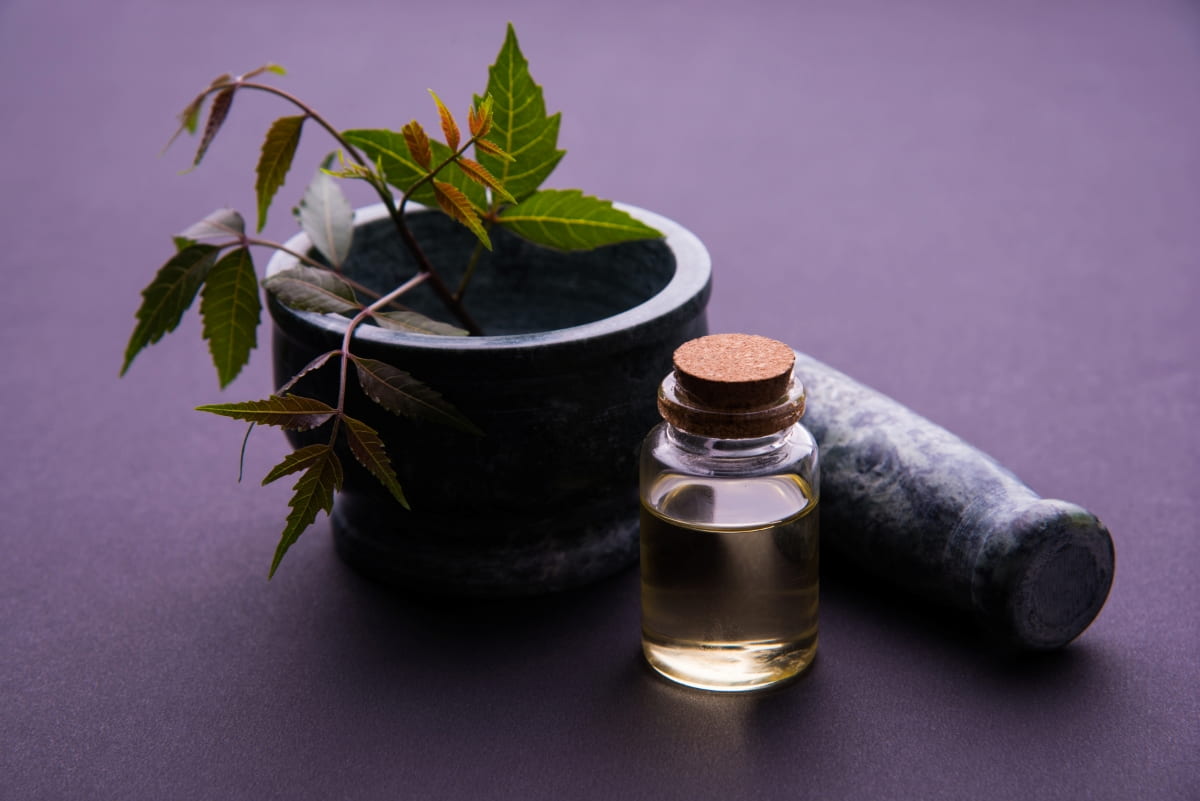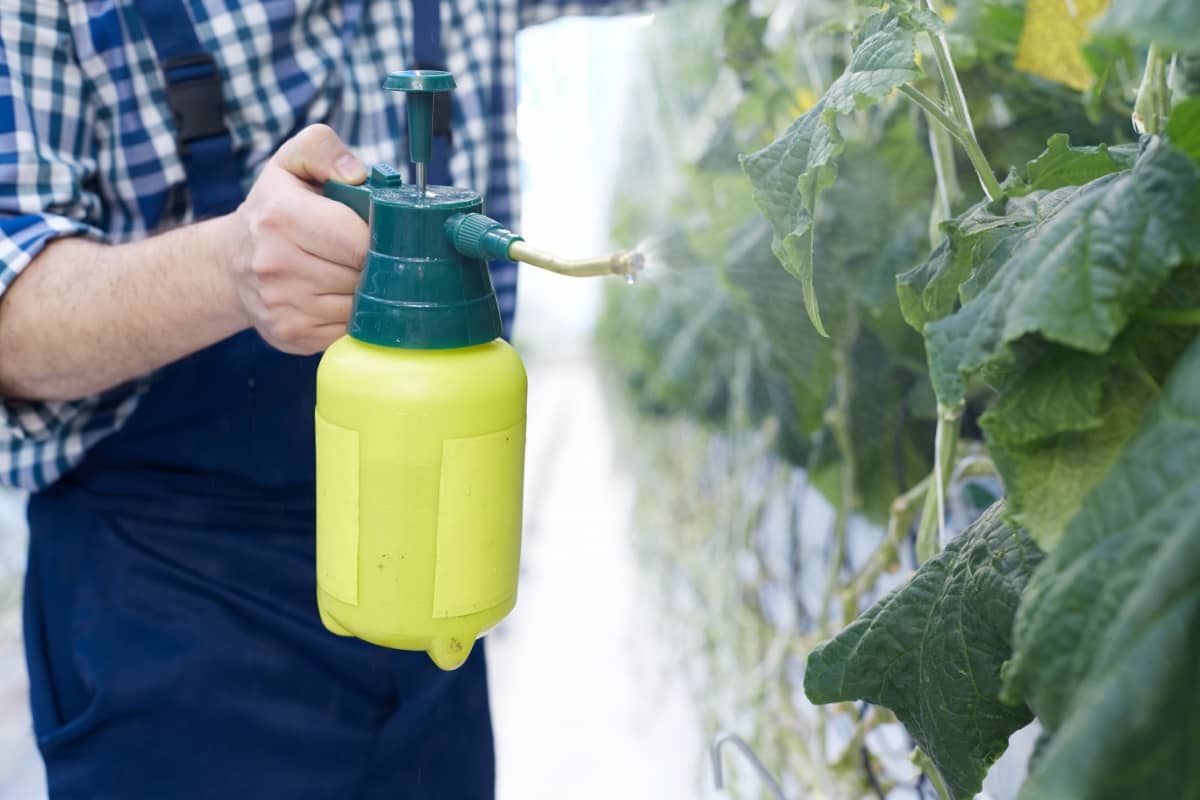Neem oil benefits cucumber plants by acting as a natural pesticide and fungicide. Its antifungal and antibacterial properties help combat common cucumber ailments like powdery mildew and downy mildew. Neem oil disrupts the life cycle of pests, preventing their reproduction. Additionally, it serves as a deterrent, keeping harmful insects at bay.

The oil is safe for plants, humans, and beneficial insects, making it an eco-friendly choice. This simple application helps promote a healthier cucumber crop, ensuring a bountiful harvest while minimizing the need for harsh chemical interventions.
Using Neem Oil on Cucumber Plants
How to Use Neem Oil to Protect Your Cucumber Plants from Pests: A Step-By-Step Guide
- Select a pure, cold-pressed neem oil from a reputable source.
- Mix 1-2 tablespoons of neem oil with 4 liters of water. A few drops of mild dish soap liquid can be added to this solution in order to adhere to the surfaces of plants.
- Thoroughly mix them to ensure an even distribution of neem oil.
- Transfer the neem oil solution to a garden sprayer. Pump or pressurize the sprayer according to its instructions.
- Spray the neem oil solution generously on both sides of cucumber leaves, focusing on affected areas and the undersides of leaves where pests often reside.
- Apply the neem oil solution every 7-14 days, especially after rain or watering, to maintain protection throughout the growing season.
- Monitor your cucumber plants for signs of pests or diseases. Reapply neem oil as needed.
How Neem Oil Works to Shield Cucumber Plants from Diseases: The Science Explained
Neem oil shields cucumber plants through its active compounds like azadirachtin, which disrupts the life cycle of pests by affecting their feeding, mating, and oviposition. It acts as an antifeedant, making the foliage less appealing to insects. The oil’s fungicidal properties inhibit the development of common cucumber diseases like powdery mildew, suppressing fungal growth and preventing spore germination.
Neem oil also enhances the plant’s natural defenses, triggering systemic responses that fortify cucumber tissues against pathogens. This multifaceted approach makes neem oil an effective and sustainable solution for protecting cucumber plants from various pests and diseases.
Making a Neem Oil Solution for Taking Care of Your Cucumber Plants: A Detailed Walkthrough
Create a neem oil solution for your cucumber plants by mixing 1-2 tablespoons of cold-pressed neem oil with a gallon of water. Add some mild dish soap liquid to aid dispersion. Stir the mixture thoroughly. Transfer the solution to a garden sprayer, ensuring proper pressurization. Spray the neem oil solution generously on both sides of the cucumber leaves, emphasizing the affected areas and the undersides of the leaves.
In case you missed it: How to Grow Hydroponic Cucumber: A Step-by-Step Guide

Apply every 7-14 days, especially after rain. This simple concoction harnesses neem oil’s natural properties to fortify your cucumber plants against pests and diseases, promoting a healthy and thriving crop.
Recognizing Common Pests on Cucumber Plants and Treating Them with Neem Oil
Identifying common cucumber pests like aphids, spider mites, and whiteflies is crucial. To combat them with neem oil, mix 1-2 tablespoons with a gallon of water, adding a few drops of mild soap. Detect pests early by inspecting leaves and stems for discoloration or webs. Using a sprayer, apply the neem oil solution, targeting both sides of the leaves.
As a natural deterrent, neem oil disrupts pests’ feeding and reproductive cycles. Treat affected areas every 7-14 days, ensuring thorough coverage. Neem oil’s organic nature makes it an effective, eco-friendly solution for safeguarding cucumber plants and promoting a pest-resistant, healthy harvest.
Getting the Most out of Neem Oil for Your Cucumber Plants: What to Do and What to Avoid
Do’s
- Mix 1-2 tablespoons of neem oil with 4 liters of water and add a few drops of mild soap to enhance coverage.
- Spray the solution every 7-14 days, especially after rainfall or watering, to establish a consistent protective barrier.
- Ensure thorough coverage by spraying neem oil on the tops and undersides of cucumber leaves.
- Keep an eye on plant health, and reapply neem oil if pests or diseases persist.
Don’ts
- Stick to recommended dilutions to prevent potential harm to plants.
- Apply neem oil in the cooler hours of the day to avoid leaf burn.
- Minimize neem oil application when plants are flowering to protect pollinators.
- Avoid combining neem oil with synthetic pesticides, which may diminish its effectiveness.
When and How Often to Apply Neem Oil to Cucumber Plants for Best Results
Application Timing
- Early Prevention: As a preventive measure, begin neem oil applications when plants are in their early growth stages.
- Regular Checkups: Inspect cucumber plants regularly for signs of pests or diseases. If identified, start neem oil treatment promptly.
Application Frequency
- Initial Application: Apply neem oil when cucumber plants are 2-3 weeks old and repeat every 7-14 days.
- After Rain or Watering: Reapply neem oil following rainfall or watering to maintain protection, as these events can dilute the solution.
- Throughout Growing Season: Continue applications throughout the growing season until harvest for consistent pest and disease control.
In case you missed it: Growing Burpless Cucumber: Varieties, Origin, Planting, and Care

Fixing Common Problems when Using Neem Oil on Cucumber Plants: Tips and Solutions
- If neem oil residue accumulates on leaves, reduce the concentration in the solution or adjust the application frequency. Ensure thorough coverage without excess.
- Rotate neem oil with other organic pesticides to prevent pests from developing resistance. Follow recommended dilution ratios and application intervals.
- Apply neem oil during cooler parts of the day to prevent leaf burn, especially in high temperatures. Adequate dilution and proper coverage help mitigate this issue.
- Increase neem oil concentration slightly or combine it with other compatible organic treatments for a synergistic effect.
- If plants show signs of stress, discontinue neem oil temporarily and resume at a lower concentration or less frequently. Monitor plant response closely.
Combining Neem Oil with a Holistic Approach to Keep Your Cucumber Plants Healthy
- Grow companion plants like marigolds or nasturtiums to repel pests naturally and attract beneficial insects.
- Water consistently, keeping the soil consistently moist but not soggy. Drip irrigation minimizes leaf wetness, reducing the risk of fungal diseases.
- Ensure well-draining soil to avoid root rot and other soil-borne issues. Amend the soil with organic matter for optimal fertility.
- Apply organic mulch around plants to retain soil moisture, suppress weeds, and regulate soil temperature.
- Provide a balanced fertilizer to meet cucumber plants’ nutritional needs, enhancing their vigor and resistance to stress.
Long-Term Benefits of Neem Oil for Cucumber Plants: Boosting Growth and Yield
Neem oil offers enduring advantages for cucumber plants, enhancing growth and yield over the long term. Its natural properties bolster plant immunity, reducing susceptibility to diseases and pests. Regular neem oil applications foster a robust, stress-resistant crop, promoting vigorous vegetative growth and optimized flowering.
In case you missed it: How to Pollinate Cucumbers by Hand: Natural Pollination Methods, and Tips

Improved resistance to environmental stressors ensures sustained productivity and higher cucumber yields. Additionally, neem oil’s eco-friendly nature fosters a balanced and thriving garden ecosystem, contributing to your cucumber plants’ long-term health and sustainability.
Conclusion
In conclusion, employing neem oil on cucumber plants is a straightforward, eco-friendly pest and disease management solution. This step-by-step guide ensures optimal results by providing a balanced approach to application. With its natural benefits and minimal environmental impact, neem oil is a reliable ally in nurturing healthy and thriving cucumber crops, promising a bountiful harvest for gardening enthusiasts.
- Feed Your Flock for Less: Top 10 Tips to Save on Chicken Feed
- Ultimate Guide to Ossabaw Island Hog: Breeding, Raising, Diet, and Care
- Hatching Answers: The Top 10 Reasons Your Chickens Aren’t Laying Eggs
- Eggs and Economics: Breaking Down the Cost of Raising Backyard Chickens
- Defend Your Greens: Proven Methods to Keep Iguanas Out of Your Garden
- Ultimate Guide to Cinnamon Queen Chicken: A Comprehensive Guide for Beginners
- Ultimate Guide to California Tan Chicken: Breeding, Raising, Diet, Egg-Production and Care
- Ultimate Guide to Marsh Daisy Chicken: Breeding, Raising, Diet, and Care
- 10 Types of Chicken Farming Businesses You Can Start for Profits